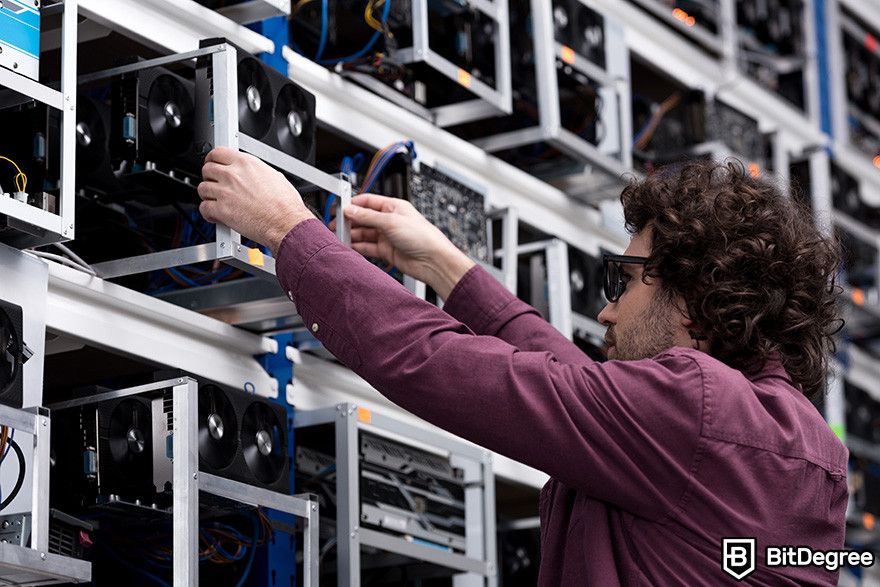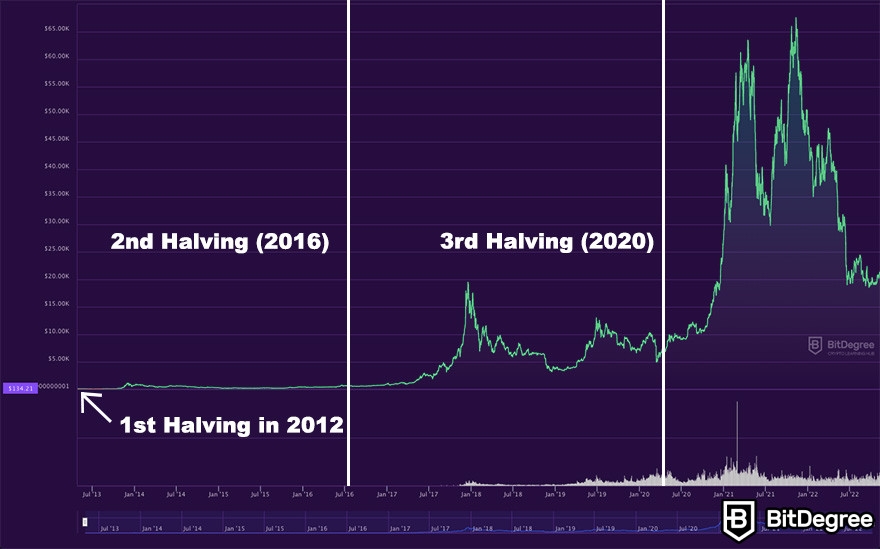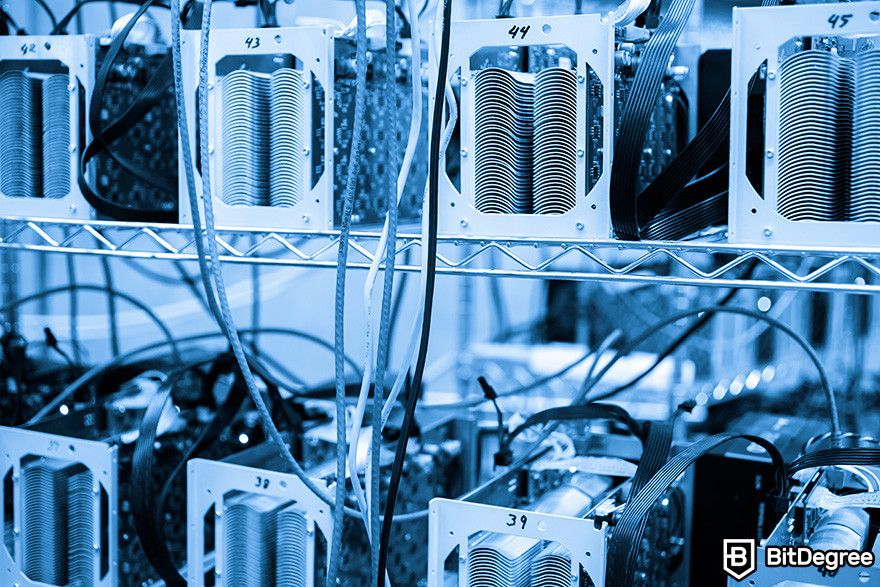 Beta
Beta
Learn2Earn in a Metaverse
Track Crypto Portfolio, Get Signals & Earn
Notify Me! Beta
Beta
Learn2Earn in a Metaverse
Track Crypto Portfolio, Get Signals & Earn
Notify Me!My Learnlist: Coming Soon!
Learn by real-life examples: Select, Track & Understand any cryptos with the unique Learnlist feature!
Portfolio: Coming Soon!
Set your wallet & get powerful insights backed by data. Easily learn how to use it for your highest rewards!
Bitcoin Halving Countdown
Time remaining until Bitcoin block rewards will be cut in half:
Bitcoin
BTC| Halving | Est. Halving Date | Block | Block Reward |
|---|---|---|---|
| #1 | November 28, 2012 | 210,000 | 25 BTC |
| #2 | July 09, 2016 | 420,000 | 12.5 BTC |
| #3 | May 11, 2020 | 630,000 | 6.25 BTC |
| #4 | Sometime in 2024 | 840,000 | 3.125 BTC |
| #5 | Sometime in 2028 | 1,050,000 | 1.5625 BTC |
Market Cap
$520,755,560,198
Circulating Supply
19,380,362 BTC
Max Supply
21,000,000 BTC
Hash Rate
365.03Eh/s
Mining Difficulty
49.54T
Current Block
790,863
Current Block Reward
6.25 BTC
Block Reward After Halving
3.125 BTC
Bitcoin halving is one of the most important events in the cryptocurrency market. Throughout history, each halving brought with itself a significant surge in BTC price - thus, it is important to track the next Bitcoin halving dates and be prepared!
When is the Next Bitcoin Halving?
It's estimated that the next Bitcoin halving will happen in March 2024. The exact date is impossible to predict, but with each halving happening every 4 years or so, we can expect Bitcoin's next halving to occur in 2024. Take a look at the BTC halving countdown above - you can use it to track the exact day when the event will take place!
When Will the Last Bitcoin Halving Happen?
It is estimated that the last Bitcoin halving will take place in the year 2140. This is when the very last Bitcoin of the total 21 million BTC supply will be mined as well.
What is the Bitcoin Halving History?
Since it was first created and launched in 2009, Bitcoin has had three halving events. The very first BTC halving happened on November 28, 2012. The second halving took place on July 9, 2016. The most recent Bitcoin halving happened on May 11, 2020.
While the 4-year rule isn't set in stone, these dates show us that it does take roughly that period of time to reach each following BTC halving. That's why the next one is projected to happen in 2024.
What is Bitcoin Halving?
Now that you have the estimated next Bitcoin halving date, it's also important to take a look at the process from a closer perspective so that you can understand the significance that these halvings bear.
Bitcoin halving is a phenomenon when the mining rewards are halved. This, in turn, leads to the halving of the supply rate of new Bitcoins. In other words:
Bitcoin halving = BTC mining rewards get cut in half = half the supply of new BTC coming into the market.
Today, there are over 19 million Bitcoins in circulation. The total number of BTC that will ever exist, however, is 21 million - so, there are fewer than 2 million BTC left to be mined. However, thanks to BTC halving, these 2 million Bitcoins won't be mined for another hundred years or so.
In order to fully comprehend the process of halving, you first need to understand how the underlying technology behind Bitcoin - its blockchain - works.
Bitcoin's Blockchain & Proof-of-Work
Since you're looking for Bitcoin halving dates, you're probably already well aware that Bitcoin is built on a unique piece of technology known as "the blockchain".
Essentially, a blockchain is a digital ledger (database) where information is stored. In regards to Bitcoin (as well as other cryptocurrencies), this information comes in the form of transactions.
Transactional information is stored within blocks, which are then connected chronologically - this way, it's clear when each and every single transaction happened. It also helps avoid such controversial issues as double-spending.

Each block contains a set number of transactions. In order for those transactions to be confirmed as legitimate and the block to be added to the blockchain, some form of a validation process is required. This is where miners come in - people who are often the most concerned with the next Bitcoin halving dates.
Miners employ either their personal computers or fancy mining machines to confirm the transactions happening on the blockchain. These confirmations are done via the computers (machines) solving super-complex mathematical equations. As soon as a miner successfully solves those equations and verifies a block, they receive the block reward - an amount of BTC that is determined each Bitcoin halving cycle.
This process is called "Proof-of-Work" - at least, that's its shortened version. What does all of that have to do with Bitcoin halving dates, though?
How Does Bitcoin Halving Work?
As I've already established, based on the Bitcoin halving schedule, which is estimated every 4 years or so, the rewards that miners receive and the number of Bitcoin mined are reduced in half. The halving (and mining reward) schedule currently looks like this:
- 2009 (the creation of Bitcoin) - 50 BTC
- 2012 - 25 BTC
- 2016 - 12.5 BTC
- 2020 - 6.25 BTC
- 2024 (the next Bitcoin halving) - 3.125 BTC
- 2028 - …
So, while miners used to receive 50 BTC as a reward for confirming a block back in 2009, throughout the years, this process has become much more competitive and difficult to do, and the rewards have dipped significantly, as well. Take a look at the table below for more information:
| DATE | BLOCK HEIGHT | MINING REWARD (BLOCK) |
|---|---|---|
| Jan. 3, 2009 | 0 | 50 BTC |
| Nov. 28, 2012 | 210,000 | 25 BTC |
| Jul. 9, 2016 | 420,000 | 12.5 BTC |
| May 11, 2020 | 630,000 | 6.25 BTC |
| Est. Mar. 2024 | 840,000 | 3.125 BTC |
| ... | ... | ... |
| Est. 2140 | Approx. 6,920,000 | Negligible |
Table: Bitcoin halving schedule
In essence, Bitcoin halving is a process that was implemented into Bitcoin's code during its development. The purpose of this phenomenon is to artificially drive up the price inflation aspect of said cryptocurrency.
The Bitcoin halving cycle happens every 210,000 blocks mined. Since the average time to mine a single block is around 9-10 minutes, this equates to roughly 4 years for each halving to take place.
With the assumption that BTC will grow in just how much it's being adopted by the masses, the fact that it becomes more difficult to mine should then naturally drive its price up significantly.
How do Bitcoin Halvings Affect the Price of BTC?
One of the reasons why Bitcoin halving dates are as anticipated as they are is related to the price of BTC - or rather, what happens with it after the halving occurs.
After and around each BTC halving date, the price of this particular cryptocurrency asset skyrockets - at least, that has been the case with the three halvings that have already occurred throughout the Bitcoin halving history.
Right before the first halving in 2012, BTC cost around $12. In anticipation of the upcoming halving and thanks to other events coinciding with this event, the asset peaked at a price of over $1,200 after the first halving.
The second halving was probably among the most notable ones, both due to the price change that Bitcoin saw, as well as due to the fact that it coincided with what we now call the "Crypto Winter" - a huge bull run, followed by an unprecedented crash.
Before the second halving, Bitcoin's price was at around $650. As the halving happened and the market started entering into some bullish sentiments, BTC eventually reached a price tag of *almost* $19,000! Then, the Crypto Winter happened, and the price of all cryptocurrencies took a huge hit - BTC fell to under $4,000 at its lowest point.

Before the last halving in 2020, Bitcoin's price was at around $9,000. After the halving, BTC reached a record price of $67,549 before once again crashing down to around $20,000 and staying in that range for a while.
Now, a big point that needs to be emphasized (and taken into account) here is that while analyzing Bitcoin halving dates is useful, it also doesn't really tell us the whole story.
Take this last halving as an example. You can see the date - May 11, 2020 - and the changes in BTC price - from around $9,000 to almost $70,000 – a good year later. Following this pattern of the Bitcoin halving cycle, it can be easy to mistakenly assume that the huge price swings are a direct result of these halvings.
The reality, however, is a bit different. Instead, these price swings are usually a combination of events, with the Bitcoin halving being just one of them. Throughout 2021, the entire cryptocurrency market saw a huge surge in popularity, which, in turn, influenced the price growth of most cryptocurrencies.
That being said, this doesn't take away from the fact that BTC halvings do, in fact, play a role in the Bitcoin price changes. These events are quite anticipated and showcase a clear pattern - whether or not it will remain this way with the next Bitcoin halving dates, we'll need to wait and see.
What are the Bitcoin Halving Price Predictions for 2024?
As the Bitcoin halving dates approach, there's always an increase in different price predictions online and within various social crypto circles.
It's worth pointing out that, with the cryptocurrency market being so volatile and unpredictable, you could really state any number and think of a reason why it's feasible for BTC to hit that price range. Thus, any and all price predictions should be viewed with a massive grain of salt and as nothing more than entertainment.
That being said, let's take a look at how much the BTC price rose during the past Bitcoin halvings, percentage-wise.
- Between the first and the second halving, BTC started at around $12 and rose to over $1,200. This is an increase of 10,000%!
- Between the second and the third halving, BTC lingered at around the $650 mark. Then, after the halving happened, it peaked at nearly $19,000 - an increase of over 2,900%.
- The last halving saw a BTC price increase of a "measly" 750%, from around $9,000 to nearly $70,000.
Judging by the numbers provided above, the percentage of how much the price increases each halving seems to shrink 3.5-3.9 times from the previous number. So, following that logic, the BTC price prediction for the 2024 halving could be an increase of approximately 200% from its lowest point.
Such predictions are less-than-optimistic - that's true. However, allow me to reiterate an earlier point - all of this is just for entertainment purposes, and BTC price predictions shouldn't ever be taken seriously!
If you'd like to analyze the BTC price trends of the past and make predictions of your own, you may do so by checking out the Bitcoin performance charts on our Cryptocurrency Tracker.
The Significance of Bitcoin Halvings
Whether you're looking forward to the Bitcoin halving of 2024 or are researching this concept as a whole, it's undeniable that these once-every-4-years events hold a lot of significance to multiple different groups of people.
In order to understand how they correlate, though, it's important to take a look at each group individually. Only then will you be able to understand the multi-dimensional nature of this phenomenon.
Investors
Naturally, whenever most people think about Bitcoin halving dates, those thoughts are immediately followed by considerations of how it will affect the BTC price. This latter topic is primarily relevant to investors.
Indeed - crypto investors are among the most-impacted groups, as far as these halvings are concerned. As history shows, though, investors actually tend to be very excited about an upcoming halving since it tends to impact Bitcoin's price in a very positive way.
Many investors choose to accumulate Bitcoin throughout the years, leading up to the halving. While BTC could experience multiple price swings throughout that time, investors believe that the surge in price after the halving event will be so significant that they will still end up making a profit.

However, while this tactic is popular, it's not guaranteed. While the Bitcoin halving schedule estimation is pretty straightforward, and the results so far have been semi-conclusive, it doesn't *guarantee* a price increase by any means. That is, however, one of the goals of the halving - to cause synthetic inflation of the BTC price, as well as make it more scarce.
While these plans make sense from a long-term perspective, things might not always work out as planned in the short term.
This is also a big reason why making Bitcoin halving price predictions is "a stab in the dark" and can even be dangerous. While you could pull any number out and present it as a feasible price target, the reality of the crypto market is often far more complex.
In other words, there are many elements that go into the price changes, and even on the next Bitcoin halving date in 2024, there are likely going to be multiple aspects that affect the price.
Miners
While it's easy to think about investors and price changes, Bitcoin halving dates mean an entirely different thing to BTC miners. Specifically, if you were to ask most miners what they think about the BTC halving cycle, the opinions that you'd get back would probably be quite two-sided.
That's because Bitcoin's halving affects miners positively as much as it does negatively. The positives are pretty self-explanatory - with each halving, BTC becomes more scarce, which in turn drives up its demand within the market (at least theoretically). This would result in more people wanting to own Bitcoin, more traffic on the network, and more profits for the miners.
As you've probably gathered by now, though, it's really a double-edged sword. This is primarily due to the variety of mining power that Bitcoin miners possess.
You see, a Bitcoin miner could be someone who has set up a mining program on their personal computer. At the same time, there are huge mining farms out there - entire companies that operate hundreds of mining rigs! As you might expect, this creates some very unfavorable conditions for the solo miners out there.

Now, imagine that you mine BTC on your laptop and have to compete with a large company that has countless mining-specific rigs. To top that off, every 4 years or so, the next Bitcoin halving date comes, and the mining rewards get cut in half. This makes an already-difficult process much more complicated!
With rising electricity costs and BTC becoming increasingly more difficult to mine, many solo miners turn to other cryptocurrencies. This, in turn, makes the Bitcoin network less secure, as there are fewer miners to verify transactions and prevent attacks on the network - a really tricky situation to be in!
One mitigating factor to all of this is mining pools. Solo miners can team up and join a mining pool - this makes solo mining much more approachable, albeit it still doesn't solve the core, underlying issue at hand.
So, as far as miners are concerned, the Bitcoin halving of 2024, as well as all of the previous halvings, is a complex, two-sided issue.
The General Crypto Community
What if you're not yet an investor in BTC and don't participate in mining processes, but are already part of the crypto community as a whole - hold some altcoins, participate in DeFi, etc.? What do the BTC halving dates mean to this group of people?
Well, for starters, it's worth acknowledging that Bitcoin halvings don't only influence the price of BTC - the entire crypto market tends to follow along, as well. While it's really a "sum of its parts" type of deal, whenever a Bitcoin halving event takes place, most of the major cryptocurrencies appear to get affected as well.
Why is that the case? Well, the answer to this question is really multi-dimensional.

First of all, the approaching Bitcoin halving tends to get into the news. As news outlets write about this phenomenon, it gains more and more traction and attention from people who might have never even heard of Bitcoin. After doing some research, those same people might become interested in acquiring other cryptocurrencies themselves.
Then, you have the speculatory nature of the cryptocurrency market as a whole. With Bitcoin being the biggest crypto asset in the world, day traders and active investors understand that Bitcoin halving dates are important within the industry - thus, they try to estimate how the market will react, and invest in other coins and tokens accordingly.
On top of that, it's also important to mention that the Bitcoin halving cycle tends to correlate with the average crypto market's cycle, too. In other words, the cryptocurrency market appears to follow a roughly 4-year pattern between each bull run, with the bearish sentiments lingering in between. Whether this is a coincidence or a direct influence of the BTC halving isn't really a question that can be answered conclusively at this time.
Summary
Up to this point in the text, we've discussed everything from the Bitcoin halving dates and the history of the process all the way to price predictions and deep analysis of the concept of "halving" as it pertains to BTC.
That's a lot of information to take in and process! With that being the case, let's run down some of the core aspects that we've covered to refresh your memory!
I'll elaborate on some of them below, but the key takeaways are:
- Bitcoin halving reduces mining rewards in half;
- It happens every 4 years (give or take);
- Its purpose is to cause artificial BTC price inflation;
- In the past, BTC halvings have been followed by large price increases, and then significant drops afterward;
- While many cryptocurrencies have halving mechanics built into them, Bitcoin halvings are still the most significant and receive the most attention and news coverage.
So - as we've established, Bitcoin halving is a process that takes place approximately every 4 years. During the halving, two big things happen - the rewards that miners receive for successfully mining a BTC block get halved, and the supply rate of new BTC entering the market is reduced by half as well.
The Bitcoin halving history logs three halving events that have already happened - in 2012, 2016, and 2020. After each halving, the price of Bitcoin has grown exponentially.
While it's impossible to determine specific BTC halving dates for the future, the next event of this kind should take place sometime in March 2024. Following that, the very last halving is expected to happen in 2140. This is also when the very last Bitcoin will be mined (hitting the hard-capped supply of 21 million Bitcoins) and when miners will start receiving rewards solely from the transactions taking place on the network.
Why does the halving happen every 4 years? That's because each halving is set to take place every 210,000 Bitcoin blocks. A block takes around 10 minutes to mine (this depends on how many miners are there on the network, but the amount of time is readjusted automatically), which equates to a bit under 4 years to mine 210,000 blocks.
The purpose of the Bitcoin halving phenomenon is quite straightforward - to cause inflation of the BTC price and to make the asset scarcer – thus, hopefully, more sought-after.
Is the BTC halving a major event? Yes, it definitely is - whether you're an investor, a day trader, a miner, or simply a crypto enthusiast, BTC halvings are usually surrounded by a lot of news coverage, as well as speculations of how it will impact the prices of other cryptocurrencies, as well.
Conclusions
So, then - you are now well-versed in all things Bitcoin halving! Whether it be past halving events, future BTC halving dates, or any of the theoretical information in between, we've touched on all of the most important information regarding the phenomenon.
Don't forget to keep an eye on the Bitcoin halving countdown above - bookmark this page so that when the time comes, you will know when the halving event will happen, specifically!
Other Halving Dates




